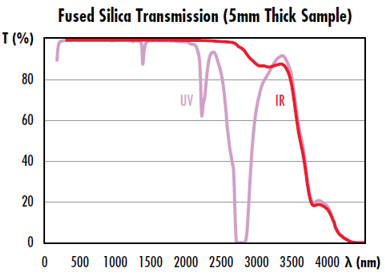UV vs. IR Grade Fused Silica
Fused silica is a common glass type used in the optics industry to manufacture optical components such as lenses, windows, mirrors, prisms, and beamsplitters. Fused silica is often a preferred material for precision optics due to its consistent and repeatable optical performance.1 Additionally, fused silica demonstrates a low thermal expansion coefficient that provides high thermal stability and resistance to thermal shocks, which are often critical characteristics in specific applications. Fused silica also has a high chemical resistance and minimal fluorescence. There are many types of fused silica, the most common include UV grade fused silica and IR grade fused silica.
UV grade fused silica is manufactured synthetically through the oxidation of high purity silicon by flame hydrolysis.2 The UV grade demonstrates high transmittance in the UV spectrum, but there are dips in transmission centered at 1.4µm, 2.2µm, and 2.7µm due to absorption from hydroxide (OH-) ion impurities.
IR grade fused silica differs from UV grade fused silica by its reduced amount of OH- ions, resulting in higher transmission throughout the NIR spectrum and reduction of transmission in the UV spectrum (Figure 1). OH- ions can be reduced by melting high-quality quartz or using special manufacturing techniques.3

Figure 1: Transmission data for UV and IR grade fused silica for a 5mm thick sample without Fresnel reflections1
Developments in lasers with wavelengths around 2µm, including thulium (2080nm) and holmium (2100nm), have led to many more applications utilizing lasers in the 2µm wavelength region. 2µm is close to one of the OH- absorption peaks in UV grade fused silica, making IR grade fused silica a much better option for 2µm applications. The high absorption of UV grade used silica around 2µm will lead to heat generation and potentially cause damage. However, IR grade fused silica optical components often have a higher cost and lower availability.
Understanding your application’s wavelength range is important for selecting the appropriate substrate. Edmund Optics® offers select optical components with IR grade fused silica (Corning 7979) and UV grade fused silica (Corning 7980) substrate options. For assistance in selecting the correct fused silica product for your application, please contact our free engineering support.
Download Corning Fused Silica Data Sheet
References
- “Corning HPFS® 7979, 7980, 8655 Fused Silica.” Corning, February 2014.
- Linow, Sven, et al. “Experimental Study of the Synthesis of Fused Silica by Direct Combustion Hydrolysis.” Experiments in Fluids, vol. 32, no. 1, Jan. 2002, pp. 66–75., doi:10.1007/s003480200007.
- Nürnberg, Frank, et al. “IR Grade Fused Silica for High-Power Laser Applications.” ICOL, Mar. 2014, doi:10.13140/2.1.2604.8007.































본사 및 지사별 연락처 확인하기
견적 요청 도구
재고 번호 입력 필요
Copyright 2023, 에드몬드옵틱스코리아 사업자 등록번호: 110-81-74657 | 대표이사: 앙텍하우 | 통신판매업 신고번호: 제 2022-서울마포-0965호, 서울특별시 마포구 월드컵북로 21, 7층 (서교동, 풍성빌딩)